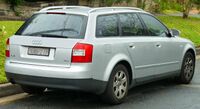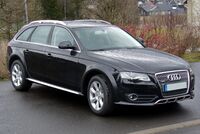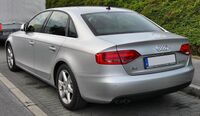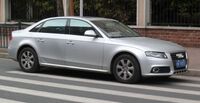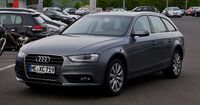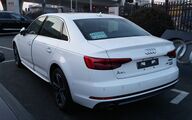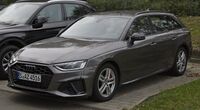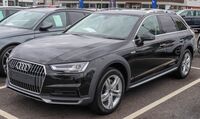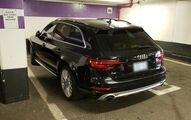Engineering:Audi A4
| Audi A4 | |
|---|---|
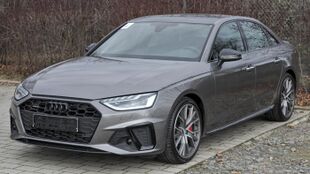 Audi A4 (B9; facelift) | |
| Overview | |
| Manufacturer | Audi AG |
| Production | 1994–present |
| Assembly |
|
| Body and chassis | |
| Class | Compact executive car (D) |
| Body style | 4-door saloon 5-door estate 2-door cabriolet (2002–2009) |
| Layout | Front-engine, front-wheel-drive or quattro permanent four-wheel-drive |
| Platform | Volkswagen Group B platform (1994–2008) Volkswagen Group MLB platform (2007–present) |
| Chronology | |
| Predecessor | Audi 80 |
The Audi A4 is a line of luxury compact executive cars produced since 1994 by the German car manufacturer Audi, a subsidiary of the Volkswagen Group. The A4 has been built in five generations and is based on the Volkswagen Group B platform. The first generation A4 succeeded the Audi 80. The automaker's internal numbering treats the A4 as a continuation of the Audi 80 lineage, with the initial A4 designated as the B5-series, followed by the B6, B7, B8, and the B9.
The B8 and B9 versions of the A4 are built on the Volkswagen Group MLB platform shared with several models and brands across the Volkswagen Group. The Audi A4 automobile layout consists of a front-engine design, with transaxle-type transmissions mounted at the rear of the engine. The cars are front-wheel drive, or on some models, "quattro" all-wheel drive. The A4 is available as a sedan and station wagon. Historically, the second (B6) and third generations (B7) of the A4 also included a convertible version. For the fourth generation (B8) and onwards, the convertible, along with a new coupé and 5-door liftback variant, was spun-off by Audi into a new nameplate called the Audi A5.
B5 (Typ 8D; 1994)
| First generation (B5/8D) | |
|---|---|
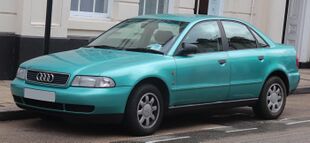 | |
| Overview | |
| Production | November 1994-September 2001 1,674,943 built[2] |
| Model years | 1995–2001 |
| Designer | Imre Hasanić (1991)[3] Jürgen Albamonte (1992) |
| Body and chassis | |
| Body style | 4 door saloon/sedan, 5-door Avant (estate/wagon) |
| Platform | Volkswagen Group B5 (PL45) platform |
| Related | Audi S4 (B5), Audi RS4 (B5), Škoda Superb, Volkswagen Passat (B5) |
| Powertrain | |
| Engine |
V6 petrol engine
Inline-four diesel engine
V6 diesel engine
|
| Transmission |
Automatic transmission
|
| Dimensions | |
| Wheelbase | 2,615 mm (103.0 in) |
| Length | 4,520 mm (178.0 in); Avant: 4,488 mm (176.7 in) |
| Width | 1,733 mm (68.2 in) |
| Height | 1,415 mm (55.7 in); Avant: 1,440 mm (56.7 in) |
The first generation Audi A4 (known internally as the Typ 8D) debuted in October 1994,[4][5] with production starting November 1994 and European sales commencing in January 1995 for the 1995 model year. North American sales later began in September 1995 for the 1996 model year.[6] It was built on the Volkswagen Group B5 (PL45) platform, which it shared with the fourth generation Volkswagen Passat (B5, Typ 3B). It had a front-mounted longitudinal engine and front-wheel drive. Many variations of the A4 were also available with Audi's quattro four-wheel drive system. The A4 was initially introduced as a four-door saloon/sedan; the Avant (estate/wagon) was introduced in November 1995 and went on sale in February 1996.
Development began in 1988, with the first design sketches being created later that year. By 1991, an exterior design by Imre Hasanic was chosen and frozen for November 1994 production by 1992. The interior design was later finalized in 1992, with pilot production commencing in the first half of 1994. Development concluded in the third quarter of 1994, preceding November 1994 start of production.[7][8][9][10]
A wide range of engines were available in European markets, between 1.6 and 2.8 litres for petrol engines; and a 1.9-litre diesel engine available with Volkswagen Group's VE technology, capable of achieving a 90 PS (66 kW; 89 bhp) or 110 PS (81 kW; 108 bhp). The 2.6 and 2.8-litre V6 engines which had been carried over from the old 80/90 proved popular, although in North America, the 2.8-litre engine was the only V6 that was available there until 1997. A 2.4-liter version was developed especially for the Thai market, where import duty jumped from 60 to 100 percent on cars of over 2,400 cc displacement.[11]
The Audi A4 was the first model in the Volkswagen Group to feature the new 1.8-litre 20v engine with five valves per cylinder, based on the unit Audi Sport had developed for their Supertouring race car. A turbocharged 1.8T version produced 150 PS (110 kW; 148 bhp) and 210 N⋅m (155 lb⋅ft) torque. Moreover, a quattro GmbH special edition of the B5 1.8T was later available in Germany and Europe, for which the engine's power output was raised to 180 PS (132 kW; 178 bhp) and 235 N⋅m (173 lb⋅ft). Five-valve technology was also added to a reengineered V6 family of engines in 1997, starting with the 2.8-litre V6 30v, which now produced 193 PS (142 kW; 190 bhp), followed by a 2.4-litre V6 which was a downsize from the previous 2.6 litre, 150 hp (112 kW) engine, but with a power increase to 165 PS (121 kW; 163 bhp).
Audi also debuted their new tiptronic automatic transmission on the B5 platform, based on the unit Porsche developed for their 964-generation 911. The transmission is a conventional automatic gearbox with a torque converter offering the driver a fully-automatic operation or manual selection of the gear ratios.
The B5 marked Audi's continued move into the midsize luxury car segment, having started this trajectory notably with later model years of the preceding Audi 80/90 B4. Despite initial mechanical problems, overall build and assembly quality were lauded both by the automotive press and within Audi and Volkswagen, and at the time, parent company Volkswagen declared the B5 the company-wide build quality benchmark for all its other models.
Facelift (1999–2001)
The Audi A4 B5 saw nearly constant minor changes and alterations throughout its seven-year run. Moreover, a significant facelift was introduced for the 1998 B5 model year at the 1997 Frankfurt Motor Show, with sales beginning in Europe in early 1998. The 2.8-litre 30-valve V6 engine replaced the 2.8-litre 12-valve. A 2.5-litre V6 Turbocharged Direct Injection diesel engine with 150 PS (110 kW; 148 bhp) was standard on the Quattro. A six-speed manual gearbox was available, as well as the new high-performance Audi S4, now part of the A4 lineup (the previous S4 had been an Audi 100). Cosmetic updates included new rear lights, headlights, door handles, and another minor exterior/interior changes.
In mid-1998, the 1.8 20vT engine available outside Europe had its power output raised to 170 PS (125 kW; 168 bhp). The previous KKK K03 turbocharger, although fundamentally unchanged, received revisions on the turbine side to prevent cracking due to heat.[citation needed] The 12-valve V6 was replaced by the 30-valve unit which had been available in Europe for two years.
A further facelift took place across the A4 and S4 platform in February 1999 as a 1999.5 model; changes were largely cosmetic but affected many components, such as both front and rear bumpers, the front and rear lights, the center console, and door handles.[12] This facelift was known at Audi as a Grosse Produktaufwertung (Major Product Upgrade), as was also signified by facelift cars now carrying the denomination "8D2".
In 1999 Audi also debuted an even higher performance RennSport model (rennsport literally translates as racing sport), the RS4 Avant, like its predecessor RS2, available only in the Avant bodystyle.
Engines
The following engines were available:
| engine type | max. power | max. torque | top speed (saloon) |
0–100 km/h (62 mph) (saloon) (manual) |
years | CO2 emissions[13][failed verification] |
|---|---|---|---|---|---|---|
| petrol engines all fuel injected | ||||||
| 1.6 I4 8v SOHC | 101 PS (74 kW; 100 bhp) | 140 N⋅m (103 lbf⋅ft) | 191 km/h (118.7 mph) | 11.9 s | 1994–2001 | 174 g/km |
| 1.6 I4 8v SOHC | 102 PS (75 kW; 101 bhp) | 148 N⋅m (109 lbf⋅ft) | 191 km/h (118.7 mph) | 11.9 s | 2000–2001 | 192 g/km |
| 1.8 I4 20v DOHC | 125 PS (92 kW; 123 bhp) | 173 N⋅m (128 lbf⋅ft) | 205 km/h (127.4 mph) | 10.5 s | 1994–2001 | 182 g/km |
| 1.8T I4 20v DOHC Turbo | 150 PS (110 kW; 148 bhp) | 210 N⋅m (155 lbf⋅ft) | 222 km/h (137.9 mph) | 8.3 s | 1994–2001 | 182 g/km |
| 1.8T I4 20v DOHC Turbo | 180 PS (132 kW; 178 bhp) | 235 N⋅m (173 lbf⋅ft) | 233 km/h (144.8 mph) | 7.9 s | 1997–2001 | 194 g/km |
| 2.4 V6 12v SOHC | 150 PS (110 kW; 148 bhp) | 207 N⋅m (153 lbf⋅ft) | 220 km/h (136.7 mph) | 9.1 s | 1996–1997 (Only in Thailand, for tax reasons) | |
| 2.4 V6 30v DOHC
BDV Engine |
165 PS (121 kW; 163 bhp) | 230 N⋅m (170 lbf⋅ft) | 225 km/h (139.8 mph) | 8.4 s | 1997–2001 | 226 g/km |
| 2.6 V6 12v SOHC | 150 PS (110 kW; 148 bhp) | 225 N⋅m (166 lbf⋅ft) | 220 km/h (136.7 mph) | 9.1 s | 1994–1997, 1997–2000 (Indonesia) | |
| S4 2.7 V6 30v Biturbo | 265 PS (195 kW; 261 bhp) | 400 N⋅m (295 lbf⋅ft) | 250 km/h (155.3 mph) | 5.7 s | 1997–2001 | |
| RS4 2.7 V6 30v Biturbo | 381 PS (280 kW; 376 bhp) | 440 N⋅m (325 lbf⋅ft) | 262 km/h (162.8 mph) | 4.9 s | 1999–2001 | |
| 2.8 V6 12v SOHC | 174 PS (128 kW; 172 bhp) | 245 N⋅m (181 lbf⋅ft) | 230 km/h (142.9 mph) | 8.2 s | 1994–1997 | |
| 2.8 V6 30v DOHC | 193 PS (142 kW; 190 bhp) | 280 N⋅m (207 lbf⋅ft) | 240 km/h (149.1 mph) | 7.4 s | 1997–2001 | |
| diesel engines all Direct Injection (DI) | ||||||
| 1.9 DI I4 8v SOHC | 75 PS (55 kW; 74 bhp) | 150 N⋅m (111 lbf⋅ft) | 158 km/h (98.2 mph) | 1996–2001 | ||
| 1.9 TDI I4 8v SOHC | 90 PS (66 kW; 89 bhp) | 202 N⋅m (149 lbf⋅ft) | 168 km/h (104.4 mph) | 13.3 s | 1994–1997 | 125 g/km |
| 1.9 TDI I4 8v SOHC | 90 PS (66 kW; 89 bhp) | 210 N⋅m (155 lbf⋅ft) | 168 km/h (104.4 mph) | 13.3 s | 1997–2001 | 143 g/km |
| 1.9 TDI I4 8v SOHC | 110 PS (81 kW; 108 bhp) | 225 N⋅m (166 lbf⋅ft) | 183 km/h (113.7 mph) | 11.3 s | 1994–1997 | 114 g/km |
| 1.9 TDI I4 8v SOHC | 110 PS (81 kW; 108 bhp) | 235 N⋅m (173 lbf⋅ft) | 183 km/h (113.7 mph) | 11.3 s | 1997–2000 | 114 g/km |
| 1.9 TDI I4 8v SOHC PD | 115 PS (85 kW; 113 bhp) | 285 N⋅m (210 lbf⋅ft) | 185 km/h (115.0 mph) | 10.5 s | 2000–2001 | 123 g/km |
| 2.5 V6 TDI 24v DOHC | 150 PS (110 kW; 148 bhp) | 310 N⋅m (229 lbf⋅ft) | 210 km/h (130.5 mph) | 9.0 s | 1997–2001 | 184 g/km |
Safety
In the Euro NCAP safety and crash tests, the Audi B5 A4 received 3 stars for front- and side-impact protection, but the last star is flagged to indicate that the driver may be subjected to a high risk of chest injury in the side impact.[14]
- Pedestrian =



 (pre 2002 rating)
(pre 2002 rating)
Derived hybrid version
In 1997, Audi was the first European car manufacturer to put a hybrid vehicle into mass production, the third generation Audi duo, then based on the A4 Avant.[15][16]
B6 (Typ 8E/8H; 2000)
| Second generation (B6/8E/8H) | |
|---|---|
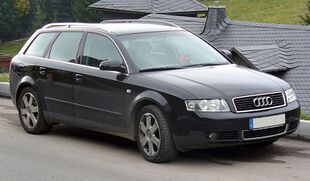 | |
| Overview | |
| Production | 2000–2006 (Europe) 2003–2005 (China; FAW-VW) |
| Model years | 2001–2005 2002–2006 (convertible) |
| Designer | Peter Schreyer (1997) Luc Donckerwolke (Avant) |
| Body and chassis | |
| Body style | 4-door saloon/sedan 5-door Avant (estate/wagon) 2-door Cabriolet |
| Platform | Volkswagen Group B6 (PL46) platform |
| Related | Audi S4 |
| Powertrain | |
| Engine |
V6 petrol engine
V8 petrol engine
Inline-four diesel engine
V6 diesel engine
|
| Transmission | Manual Transmission
Automatic Transmission
Continuously Variable Transmission
|
| Dimensions | |
| Wheelbase | 2,650 mm (104.3 in), Cabriolet: 2,654 mm (104.5 in) |
| Length | 4,547 mm (179.0 in), Avant: 4,544 mm (178.9 in); Cabriolet: 4,573 mm (180.0 in) |
| Width | 1,766 mm (69.5 in), Cabriolet: 1,777 mm (70.0 in) |
| Height | 1,428 mm (56.2 in), Cabriolet: 1,391 mm (54.8 in) |
The next A4, internally designated Typ 8E, debuted on 10 October 2000, now riding on the Volkswagen Group B6 (PL46) platform. The car's new styling was developed under Peter Schreyer between 1996 and 1998, inspired by the Bauhaus design language of the C5 (second-generation) Audi A6 introduced in 1997. The 1.6-litre base model powerplant remained unchanged, but most other petrol/gasoline engines received either displacement increases, or power upgrades. The 1.8-litre 20-valve Turbo was now available in two additional versions, with 150 PS (110 kW; 148 bhp) or 180 PS (132 kW; 178 bhp), this one with a standard six-speed manual gearbox, while the naturally aspirated 1.6-litre inline-four engine and 2.8-litre V6 were replaced by 2.0-litre, and all-aluminium alloy 3.0-litre units, still with five valves per cylinder, the most powerful of which was capable of 220 PS (162 kW; 217 bhp) and 300 N⋅m (221 lb⋅ft) of torque. The 1.9 Turbocharged Direct Injection (TDI) engine was upgraded to 130 PS (96 kW; 128 bhp), with Pumpe Düse (Unit Injector) (PD) technology, and was now available with quattro permanent four-wheel drive, while the 2.5 V6 TDI high-end model was introduced with 180 PS (132 kW; 178 bhp) and standard quattro. This generation of quattro consisted of default of 50:50 front to rear dynamic torque distribution. A Bosch ESP 5.7 Electronic Stability Programme (ESP) system, with anti-lock braking system (ABS), brake assist, and electronic brakeforce distribution (EBD) were standard across the range.
The Avant was introduced in June 2001 and arrived in European showrooms in September 2001.[citation needed]
For 2002, Audi increased power in the 1.8 Turbo engines to 183 PS (135 kW; 180 bhp) and 190 PS (140 kW; 187 bhp) – the 190 PS variant designated by a red 'T' on the boot lid. Available with four wheel drive and in the 2.5 TDI intermediate version to 163 PS (120 kW; 161 bhp). A 2.0 engine with Fuel Stratified Injection (FSI) was also available. A year later, Audi reintroduced the S4, now powered by a 344 PS (253 kW; 339 bhp) 4.2 L V8 engine, as well as an A4 Cabriolet convertible variant (Typ 8H), finally replacing the 80-based Audi Cabriolet which had been discontinued in 2000. It included an electro-hydraulic operated roof, which lowered in under 30 seconds and incorporated some styling changes, such as body-coloured lower bumper and sill panels, which later found their way to the saloon version. The Audi A4 Cabriolet version was co-developed and manufactured by Karmann.[17]
Audi introduced a continuously variable transmission developed by LuK, named multitronic, which replaced the dated conventional automatic transmission on front-wheel drive models. There have been widespread complaints from consumers around the world that the transmission box is prone to electronic glitches as well as mechanical problems.[18][19]
Borrowing from the Audi A6, the boot was redesigned to remove the extension of the top edge with a smoother fold line. The rear light assemblies now formed part of the top line, these styling cues were eventually borrowed by other European as well as Asian manufacturers.[20]
A sport package named 'Ultra Sport' was introduced in the North American market shortly before the B6 was replaced by the B7. It included aluminium interior trim and door sills, "S line" steering wheel, front and rear spoilers, side skirts, and quattro GmbH designed 18-inch RS4 alloy wheels.
Engines
The following engines were available:
| engine type | cyl. | max. power |
|---|---|---|
| petrol engines all fuel injected | ||
| 1.6 | I4 | 102 PS (75 kW; 101 bhp) |
| 1.8 Turbo 20v | I4 | 150 PS (110 kW; 148 bhp) |
| 1.8 Turbo 20v | I4 | 163 PS (120 kW; 161 bhp) |
| 1.8 Turbo 20v 'S line' | I4 | 163 PS (120 kW; 161 bhp) |
| 1.8 Turbo 20v 'S line' | I4 | 190 PS (140 kW; 187 bhp) |
| 2.0 20v ALT | I4 | 131 PS (96 kW; 129 bhp) |
| 2.0 FSI | I4 | 150 PS (110 kW; 148 bhp) |
| 2.4 30v BDV | V6 | 170 PS (125 kW; 168 bhp) |
| 3.0 30v | V6 | 220 PS (162 kW; 217 bhp) |
| S4 4.2 40v | V8 | 344 PS (253 kW; 339 bhp) |
| diesel engines all Turbocharged Direct Injection (TDI) | ||
| 1.9 TDI | I4 | 100 PS (74 kW; 99 bhp) |
| 1.9 TDI | I4 | 115 PS (85 kW; 113 bhp) |
| 1.9 TDI | I4 | 133 PS (98 kW; 131 bhp) |
| 2.5 V6 TDI 24v | V6 | 155 PS (114 kW; 153 bhp) |
| 2.5 V6 TDI 24v | V6 | 163 PS (120 kW; 161 bhp) |
| 2.5 V6 TDI 24v | V6 | 180 PS (132 kW; 178 bhp) |
Safety
The Audi A4 (B6 & B7) passed the Euro NCAP safety and crash tests, and was awarded the following car safety ratings:[21]
- Pedestrian =



 (pre 2002 rating)
(pre 2002 rating)
The Insurance Institute for Highway Safety (IIHS) awarded both the B6 & B7 a "Good" rating in the frontal crash test; the B7 was not retested since the front portion is structurally the same.[22]
B7; (Typ 8E/8H; 2004)
| Third generation (B7/8E/8H) | |
|---|---|
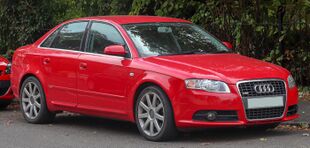 | |
| Overview | |
| Also called | SEAT Exeo |
| Production | 2004–2008 (sedan) 2006–2009 (cabriolet) 2006–2009 (China; FAW-VW) 2008-2013 (SEAT Exeo) |
| Designer | Walter de Silva (2002, 2003) |
| Body and chassis | |
| Body style | 4-door saloon/sedan, 5-door Avant (estate/wagon), 2-door Cabriolet |
| Platform | Volkswagen Group B7 (PL46) platform |
| Related | Audi S4 (B7), Audi RS4 (B7), SEAT Exeo |
| Powertrain | |
| Engine |
V6 petrol engine
V8 petrol engine
Inline-four diesel engine
V6 diesel engine
|
| Transmission | Manual Transmission
Continuously Variable Transmission
|
| Dimensions | |
| Wheelbase | 2,648 mm (104.3 in) |
| Length | 4,586 mm (180.6 in), Cabriolet: 4,573 mm (180.0 in) |
| Width | 1,772 mm (69.8 in), Cabriolet: 1,777 mm (70.0 in) |
| Height | 1,427 mm (56.2 in), Cabriolet: 1,518 mm (59.8 in) |
| Chronology | |
| Successor | Audi A5 (for A4 cabriolet) |
Audi introduced a heavily facelifted A4 in late 2004, with the internal designation of B7. Although given a new platform designation, the B7 was essentially a heavily facelifted and revised version of the B6, with revised steering settings, suspension geometry,[specify] new internal combustion engine ranges, navigation systems and chassis electronics (including a new advanced Bosch ESP 8.0 Electronic Stability Programme (ESP) system). The front grille assembly changed to a tall trapezoidal shape in the same manner as the C6 (third-generation) Audi A6; however, the dashboard and interior were virtually unchanged from the B6 aside from minor detailing.
Audi's internal platform nomenclature uses PL46 (passenger car longitudinal platform, size 4, generation 6) for both B6 and B7 chassis. The Typ 8E and Typ 8H internal designations are also carried over from the B6 A4 range, but now have an additional identifying suffix – 8EC for the saloon, 8ED for the Avant, and 8HE for the Cabriolet.
The engine lineup received many additions. The 2005 introduction of Fuel Stratified Injection (FSI) on the 2.0 TFSI and 3.2 V6 FSI petrol/gasoline engines, as well as other refinements, increased power output to 200 PS (147 kW; 197 bhp) and 255 PS (188 kW; 252 bhp), respectively. These engines both use a four-valve per cylinder configuration. The prior 5-valve design was incompatible with the FSI direct injection system (due to the siting of the fuel injector, now discharging directly into the combustion chamber). The 2.0 Turbocharged Direct Injection (TDI) diesel engine now combined Pumpe Düse (Unit Injector) (PD) technology with 16 valves, while the larger 2.5 TDI V6 diesel was superseded by a 3.0 V6 TDI, offering a 204 PS (150 kW; 201 bhp) model during the year 2005 which was upgraded to a 233 PS (171 kW; 230 bhp) model in 2006. A 2.7 V6 TDI was added later.
Torsen T-2 based quattro permanent four-wheel drive remained as an option on most A4 models. Audi retained the 5 speed manual transmission with the 1.9 TDI and 2.0 non turbo petrol engines while introducing the 6 speed manual for all higher output variants. As before, multitronic continuously variable transmission (CVT), now with selectable 'seven-speeds', was an option on front-wheel drive models, whilst a conventional ZF 6HP 6-speed tiptronic automatic transmission was an option on the quattro four-wheel drive models.
In addition to the Audi S4, which carried over the powertrain from the B6 S4 – Audi reintroduced the quattro GmbH developed Audi RS4 (RS for RennSport) to the lineup, for the first time on the saloon/sedan and Cabriolet body, and with a naturally aspirated, but high-revving 4.2-litre V8 FSI engine. Another inclusion on the RS4 was the latest generation Torsen T-3 Quattro 4WD system, which uses a 'default' asymmetric 40:60 front-rear dynamic torque distribution bias. This new asymmetric center differential was initially only available on the RS4 but was added a year later on the S4. The remainder of the B7 A4 range still used the T-2 50:50 default dynamic split center diff.

A variant, developed by quattro GmbH, was first introduced in May 2005, named "Audi A4 DTM Edition". It was inspired by Audi's race cars of the 2004 Deutsche Tourenwagen Masters and was reintroduced in 2006 as a regular option. The 2.0T FSI engine received revised software mapping to the ECU, which increased the output to 220 PS (162 kW; 217 bhp) and 300 N⋅m (221 lb⋅ft) of torque. It was available with front-wheel drive, or Quattro four-wheel drive.
The B7 Cabriolet model arrived later than the other two body variants, being first shown in late 2005 and with sales beginning in February 2006. New on the Cabriolet was an entry-level 2.0 TDI version, which was not offered with the Multitronic CVT gearbox. The Cabriolet version was produced by Karmann until February 2009.[24]
In 2007 Audi introduced a version of the B7 named the 'Special Edition', which built on the S-Line specification and also included the black optics pack, the RS4 style 8J X 18 '7-arm double-spoke' design alloy wheels, Two-tone Graphite/Black Volterra leather, 3-spoke sports leather/Alcantara multi-function steering wheel with gear knob and hand brake handle in Alcantara with silver stitching, ventilated cross-drilled front disc-brakes, black tailpipes and black roof rails (Avant model only). It also had a power increase of 20 PS, giving an output of 220 PS on the 2.0T model.
According to 2007 Swedish vehicle inspection data, the Audi A4 Avant with diesel engine is the most reliable vehicle available on the market, with vehicle inspection rejection rate of 0.0% in three-year-old category.[25][failed verification]
SEAT Exeo
When the successor B8 A4 range was introduced, the B7 series A4 was restyled and rebadged as the SEAT Exeo in 2008 with changes to the front and rear plus interior trim from the A4 Cabriolet. The entire Audi B7 A4 production line from Audi's Ingolstadt plant was dismantled and sent to Volkswagen Group's SEAT factory in Martorell, Spain.[26]
Engines
The following engines were available:
| engine type / drive |
max. power | saloon | Avant | Cabriolet | 0–100 km/h (62 mph) (saloon / manual transmission) |
top speed (saloon / manual transmission) |
|---|---|---|---|---|---|---|
| petrol engines all fuel injected | ||||||
| 1.6 | 102 PS (75 kW; 101 hp) | ✓ | ✓ | 12.6 s | 118.1 mph (190 km/h) | |
| 1.8 T | 163 PS (120 kW; 161 hp) | ✓ | ✓ | ✓ | 8.6 s | 141.7 mph (228 km/h) |
| 1.8 T quattro | 163 PS (120 kW; 161 hp) | ✓ | ✓ | 8.7 s | 140.5 mph (226 km/h) | |
| 2.0 | 130 PS (96 kW; 128 hp) | ✓ | ✓ | 9.9 s | 131.8 mph (212 km/h) | |
| 2.0 T FSI [B7 1] | 200 PS (147 kW; 197 hp) | ✓ | ✓ | ✓ | 7.1 s | 149.8 mph (241 km/h) |
| 2.0 T FSI quattro [B7 1] | 200 PS (147 kW; 197 bhp) | ✓ | ✓ | ✓ | 7.2 s | 147.9 mph (238 km/h) |
| 2.0 TFSI DTM [B7 1][B7 2] | 220 PS (162 kW; 217 hp) | ✓ | ✓ | 7.0 s | 153.5 mph (247 km/h) | |
| 2.0 TFSI DTM quattro [B7 1][B7 2] | 220 PS (162 kW; 217 hp) | ✓ | ✓ | 6.9 s | 151.7 mph (244 km/h) | |
| 3.2 V6 FSI | 255 PS (188 kW; 252 hp) | ✓ | ✓ | ✓ | 6.8 s | 155.4 mph (250 km/h) (elec. limited) |
| 3.2 V6 FSI quattro | 255 PS (188 kW; 252 hp) | ✓ | ✓ | ✓ | 6.4 s | 155.4 mph (250 km/h) (elec. limited) |
| 4.2 V8 S4 BBK | 344 PS (253 kW; 339 hp) | ✓ | ✓ | ✓ | 5.6 s | 155.4 mph (250 km/h) (elec. limited) |
| 4.2 V8 RS4 | 420 PS (309 kW; 414 hp) | ✓ | ✓ | ✓ | 4.8 s | 155.4 mph (250 km/h) (elec. limited) |
| diesel engines all Turbocharged Direct Injection (TDI) | ||||||
| 1.9 TDI | 115 PS (85 kW; 113 hp) | ✓ | ✓ | 11.2 s | 124.9 mph (201 km/h) | |
| 2.0 TDI [B7 3] | 140 PS (103 kW; 138 bhp) | ✓ | ✓ | ✓ | 9.7 s | 131.8 mph (212 km/h) |
| 2.0 TDI quattro | 140 PS (103 kW; 138 hp) | ✓ | ✓ | ✓ | 9.7 s | 128.7 mph (207 km/h) |
| 2.0 TDI | 170 PS (125 kW; 168 hp) | ✓ | ✓ | 8.6 s | 141.7 mph (228 km/h) | |
| 2.0 TDI quattro | 170 PS (125 kW; 168 hp) | ✓ | ✓ | 8.5 s | 139.2 mph (224 km/h) | |
| 2.5 V6 TDI [B7 4] | 163 PS (120 kW; 161 hp) | ✓ | ✓ | 8.8 s | 141.1 mph (227 km/h) | |
| 2.7 V6 TDI [B7 5] | 180 PS (132 kW; 178 hp) | ✓ | ✓ | ✓ | 8.4 s | 142 mph (229 km/h) |
| 3.0 V6 TDI quattro [B7 6] | 204 PS (150 kW; 201 hp) | ✓ | ✓ | 7.2 s | 146 mph (235 km/h) | |
| 3.0 V6 TDI quattro [B7 5] | 233 PS (171 kW; 230 hp) | ✓ | ✓ | ✓ | 6.8 s | 152.25 mph (245 km/h) |
- ↑ 1.0 1.1 1.2 1.3 TFSI combines turbocharger and FSI. The badge simply states 2.0 T though.
- ↑ 2.0 2.1 In 2005 only available as DTM Edition. From summer 2006 on available for all saloon and Avant.
- ↑ There were two different versions – one had an 8 valve cylinder head the other had 16 valves. They had the same power and torque output and performed equally. Customers could not choose directly between those two engines. They got the 8-valve version when they ordered the DPF otherwise they got the 16-valve version (BRE engine code). In many countries the DPF became standard equipment for all B7 diesel engines from model year 2006 on and the 8-valve engine was no more.
- ↑ Only available for model year 2005. No DPF available for this engine. In 2006 replaced by the 2.7 V6 TDI engine.
- ↑ 5.0 5.1 Not available before model year 2006.
- ↑ Only available for model year 2005. In 2006 replaced by a stronger version of the same engine.
Safety
The Audi A4 offers many standard safety features, including Bosch ESP 8.0 Electronic Stability Programme (ESP) with anti-lock braking system (ABS), side airbags in the seats, 'sideguard' curtain airbags, and its optional quattro four-wheel drive system. It also received the Insurance Institute for Highway Safety (IIHS) "Top Safety Pick For 2007".[27][28] EuroNCAP crash test results from the B6 apply to the B7 model.
B8 (Typ 8K; 2008)
| Fourth generation (B8/8K) | |
|---|---|
 | |
| Overview | |
| Production | October 2007–2015 |
| Model years | 2008–2016 |
| Assembly | |
| Designer | Julian Höenig (exterior: 2004, 2005)[30] Ingo Von Bargen (interior: 2005)[31] |
| Body and chassis | |
| Body style | 4-door saloon/sedan, 5-door Avant (estate/wagon) |
| Platform | Volkswagen Group MLB platform |
| Related | Audi A5 Audi S4 (B8) Audi RS4 (B8) |
| Powertrain | |
| Engine |
V8 petrol engine
Inline-four diesel engine
V6 diesel engine
|
| Transmission | Manual Transmission
Dual-clutch Transmission
Continuously Variable Transmission
|
| Dimensions | |
| Wheelbase | 2,808 mm (110.6 in) allroad: 2,805 mm (110.4 in) LWB: 2,869 mm (113.0 in) |
| Length | 4,703 mm (185.2 in) allroad: 4,721 mm (185.9 in) LWB: 4,763 mm (187.5 in) |
| Width | 1,826 mm (71.9 in) allroad: 1,841 mm (72.5 in) |
| Height | 1,427 mm (56.2 in) Avant: 1,436 mm (56.5 in) allroad: 1,495 mm (58.9 in) LWB: 1,426 mm (56.1 in) |

Audi released the first official pictures of the B8 series A4 in August 2007 and unveiled the car to the public at the September 2007 Frankfurt Motor Show. Saloon/sedan and Avant (estate/wagon) models are offered. The Avant was unveiled to the public at the March 2008 Geneva Motor Show. For North America's destined models, the B8 continued in production for the 2016 model year, while Europe began deliveries on the 2016 B9 model.
The B8 A4 is built on a variant of the Audi Modular Longitudinal Platform, a platform that is also used in the Audi A5 coupé. While prior A4 chassis were limited in wheelbase due to the relationship between the engine, transmission and front axle, the MLP allows for a reduced front overhang, resulting in a greater wheelbase length without the same increase in overall length.[32] This effectively redistributes the centre of gravity slightly rearwards, improving handling by better balancing vehicle mass between the front and rear axles. The estimated static front:rear weight ratio of the B8 A4 is approximately 55:45, depending on body style and engine. The relocation of the steering rack in front of the axle also improves handling over previous A4 platforms.[citation needed] Key to the implementation of MLP is the novel mounting of the differential in front of the clutch. This is achieved by driving the flywheel/clutch remotely by means of a 'top hat' shaped drive plate, between which the differential lay shaft passes, whilst power transmission to the final drive is via an inclined transfer shaft which runs the length of the transmission unit. Whilst the platform retains Audi's "overhung" engine mounting position, the front axle is now 152mm further forward than the previous B6/B7 generation platform.[33] The transfer shaft, however, has the effect of creating a large "bulge" on one side of the transmission tunnel, which on right-hand drive versions forces the pedals to be badly offset, which has attracted criticism from the British motoring press in particular.
The B8 A4 has increased in wheelbase by 160 millimetres (6.3 in) and in length by 117 millimetres (4.6 in) over the prior B7, which has allowed for increased rear seating legroom. Although the overall dimensions have increased, the curb weight has dropped some 10%. The boot (trunk) has also increased to 480 litres (17.0 cu ft) for the saloon (sedan) version. The A4 Avant will have a maximum capacity of 1,430 L (50.5 cu ft) with the rear seats folded down.
Reception has been mixed, with praise for the Audi A4's increased size, giving it best-in-class rear legroom and trunk space in the compact executive car segment.[34] Its inline-4 2.0 TFSI engine, while efficient providing plenty of torque, was considered lacking and less refined compared to 6-cylinder engines of lighter rivals who posted faster acceleration times. However, the Audi S4 sports sedan has been well-received for its V6 3.0 TFSI engine's power and efficiency.[35][36][37]
The B8 A4 was facelifted in early 2012. During a model, cycle changes are made to integrate new technologies and to keep the model competitive. These changes are referenced based on the model year (MY) of the car. In Australia, the B8 has undergone 2 revisions leading to three variants, the B8, B8 MY10[38] and B8 MY11.
Body types
Saloon / Sedan
Audi released the first official pictures of the B8 series A4 in August 2007 and unveiled the car to the public at the September 2007 Frankfurt Motor Show. Saloon/sedan and Avant (estate/wagon) models are offered.
Avant
The Avant station wagon/estate was presented at the March 2008 Geneva Motor Show.
A4 allroad quattro
The A4 Allroad Quattro is based upon the Avant but features a wider track, increased ground clearance, Quattro permanent four-wheel drive, a distinctive radiator grille, stainless steel underbody guards and roof rails.
The A4 allroad quattro was made available in early summer 2009.[39] The car was unveiled in 2009 Geneva Motor Show.[40]
A4L
The A4L is a long-wheelbase version of the sedan/saloon for the Chinese market, with a 60 mm (2.4 in) longer wheelbase and length.[41] The vehicle was presented at the 2008 Guangzhou Motor Show. The production version then went on sale in January 2009. Launch models included a 2.0 TFSI with 132 kW (177 hp) and the 3.2 FSI with 195 kW (261 hp).[42]
Specifications
Body styles
| Body | Sedan | Avant | A4L | allroad quattro |
|---|---|---|---|---|
| Year | 2011– | 2010– | 2009 | |
| Luggage capacity | 480 litres (17.0 cu ft) with the rear seats in the upright position, and 962 L (34.0 cu ft) with the seats folded | 490 L (17.3 cu ft) with the rear seats upright, and 1,430 L (50.5 cu ft) with the seats folded | ? | |
| Curb weight | 1,410 kg (3,109 lb) to 1,690 kg (3,726 lb) | 1,470 kg (3,241 lb) to 1,695 kg (3,737 lb) | ? |
The A4-based convertible models were replaced by the A5/S5 Cabriolet.
Engines
The B8 powertrain options are the following: engines, transmissions and drivelines: [43](All United Kingdom specification unless stated otherwise). [44](for South Africa specification). [45](for Australia specification). [46](for New Zealand specification).
| Model | Engine code | Years | displacement / type | Power@rpm | Torque@rpm |
|---|---|---|---|---|---|
| Petrol engines | |||||
| 1.8 TFSI | CABA/CDHA | 2008–2015 | 1,798 cc (110 cu in) 16v I4 turbo | 120 PS (88 kW; 118 hp) @4500–6200 | 230 N⋅m (170 lb⋅ft) @1500–3650 |
| 1.8 TFSI, 1.8 TFSI quattro | CABB/CDHB | 2007–2011 | 1,798 cc (110 cu in) 16v I4 turbo | 160 PS (118 kW; 158 hp) @4500–6200 | 250 N⋅m (184 lb⋅ft) @1500–4500 |
| 1.8 TFSI, 1.8 TFSI quattro | CJEB | 2011–2015 | 1,798 cc (110 cu in) 16v I4 turbo | 170 PS (125 kW; 168 hp) @3800–6200 | 320 N⋅m (236 lb⋅ft) @1400–3700 |
| 2.0 TFSI, 2.0 TFSI quattro | CDNB/CAEA/CFKA | 2008–2015 | 1,984 cc (121.1 cu in) 16v I4 turbo | 180 PS (132 kW; 178 hp) @4000–6000 | 320 N⋅m (236 lb⋅ft) @1500–3900 |
| 2.0 TFSI, 2.0 TFSI quattro | CDNC/CAEB | 2008–2013 | 1,984 cc (121 cu in) 16v I4 turbo | 211 PS (155 kW; 208 hp) @4300–6000 | 350 N⋅m (258 lb⋅ft) @1500–4200 |
| 2.0 TFSI, 2.0 TFSI quattro | CNCD | 2013–2016 | 1,984 cc (121 cu in) 16v I4 turbo | 225 PS (165 kW; 222 hp) @4500–6250 | 350 N⋅m (258 lb⋅ft) @1500–4500 |
| 3.0 TFSI quattro | CMUA | 2012–2015 | 2,995 cc (183 cu in) 24v V6 supercharged | 272 PS (200 kW; 268 hp) @4780-6500 | 400 N⋅m (295 lb⋅ft) @2150–4780 |
| 3.2 FSI, 3.2 FSI quattro | CALA | 2007–2011 | 3,197 cc (195 cu in) 24v V6 | 265 PS (195 kW; 261 hp) @6500 @5500–7000 | 330 N⋅m (243 lb⋅ft) @3000–5000 |
| S4 quattro | CAKA/CREC | 2008–2015 | 2,995 cc (183 cu in) 24v V6 supercharged | 333 PS (245 kW; 328 hp) @5500–7000 | 440 N⋅m (325 lb⋅ft) @2900–5300 |
| RS4 quattro | CFSA | 2012–2015 | 4,163 cc (254 cu in) 32v V8 | 450 PS (331 kW; 444 hp) @8250 | 430 N⋅m (317 lb⋅ft) @4000–6000 |
| Diesel engines | |||||
| 2.0 TDI | CAGC | 2008– | 1,968 cc (120 cu in) 16v I4 turbo | 120 PS (88 kW; 118 hp) @4200 | 290 N⋅m (214 lb⋅ft) @1750–2500 |
| 2.0 TDI e | CAGB | 2009– | 1,968 cc (120 cu in) 16v I4 turbo | 136 PS (100 kW; 134 hp) @4200 | 320 N⋅m (236 lb⋅ft) @1750–2500 |
| 2.0 TDI, 2.0 TDI quattro | CAGA | 2007– | 1,968 cc (120 cu in) 16v I4 variable geometry turbo | 143 PS (105 kW; 141 hp) @4200 | 320 N⋅m (236 lb⋅ft) @1750–2500 |
| 2.0 TDI e | CA | 2012– | 1,968 cc (120 cu in) 16v I4 turbo | 163 PS (120 kW; 161 hp) @4200 | 380 N⋅m (280 lb⋅ft) @1750–2500 |
| 2.0 TDI, 2.0 TDI quattro | CAHA | 2008– | 1,968 cc (120 cu in) 16v I4 variable geometry turbo | 170 PS (125 kW; 168 hp) @4200 | 350 N⋅m (258 lb⋅ft) @1750–2500 |
| 2.0 TDI, 2.0TDI quattro | CGLC | 2011- | 1,968 cc (120 cu in) 16v I4 variable geometry turbo | 177 PS (130 kW; 175 hp) @4200 | 380 N⋅m (280 lb⋅ft) @1750–2500 |
| 2.0 TDI, 2.0TDI quattro | CNHA | 2011- | 1,968 cc (120 cu in) 16v I4 variable geometry turbo | 190 PS (140 kW; 187 hp) @3800-4200 | 400 N⋅m (295 lb⋅ft) @1750–3000 |
| 2.7 TDI | CAMA/CGKA | 2007– | 2,698 cc (165 cu in) 24v V6 turbo | 190 PS (140 kW; 187 hp) @3500–4400 | 400 N⋅m (295 lb⋅ft) @1400–3250 |
| 3.0 TDI quattro | CAPA/CCWA | 2007– | 2,967 cc (181 cu in) 24v V6 turbo | 240 PS (177 kW; 237 hp) @4000–4400 | 500 N⋅m (369 lb⋅ft) @1500–3000 |
| 3.0 TDI quattro | 2011– | 2,967 cc (181 cu in) 24v V6 turbo | 245 PS (180 kW; 242 hp) @4000–4500 | 500 N⋅m (369 lb⋅ft) @1400–3250 | |
The quattro permanent four-wheel drive system uses the latest Torsen T-3 centre differential, with a default 40:60 front to rear asymmetric torque distribution ratio (used first on the B7 RS4) as standard. (Previous A4 Quattro models split torque with a default front:rear 50:50). The additional torque bias applied to the rear wheels helps mimic the driving dynamics of rear-wheel drive cars.
Audi was reported to stop offering 3.2L V6 models in 2010 model year,[47] but still offers them as of August 2011 (Germany).
All petrol engines use Fuel Stratified Injection (FSI), and all diesel engines use the common rail fuel delivery (with a pressure of 1,600 bars (23,000 psi)), with piezo injectors of their Turbocharged Direct Injection engines.
With the 2012 facelift (the B8.5) came additional 163ps TDIe and TDI Ultra engines, the latter requiring the addition of adblue allowing for cleaner running, both of which fell into the lower emissions tax bracket for the UK, yet presenting a significant performance improvement over the base 136ps and mid-range 143ps models.[48]
Transmissions
In 2009, Audi announced the seven-speed S-Tronic dual-clutch automatic transmission as an option for A4 in the UK and European markets.[49]
All A4L models include Speed 8 multitronic continuously variable/manual transmission, except for A4L 3.2 FSI quattro, which includes Tiptronic automatic transmission.
Volkswagen settled a class-action lawsuit in 2013 involving the failures of the CVT transmission in its Audi A4 and A6 automobiles for model years 2002–2006.[50]
Performance
| Vehicle model, transmission | Acceleration 0–100 km/h (62 mph) (s) (saloon) |
top speed (saloon) | CO2 emissions (g/km) (saloon) (Directive 80/1268/EEC) |
notes |
|---|---|---|---|---|
| 2.0 TFSI, 6-speed Manual | 6.9 | 250 km/h (155 mph) (elec. limited) | 149 | |
| 1.8 TFSI, 6-speed Manual | 8.6 | 225 km/h (140 mph) | 164 | |
| 1.8 TFSI, 8-speed Multitronic CVT | 8.6 | 225 km/h (140 mph) | 169 | |
| 2.0 TFSI, 8-speed Multitronic CVT | 8.2 | 236 km/h (147 mph) | 167 | Aus/NZ/ZA only |
| 2.0 TFSI, 8-speed Multitronic CVT | 6.9 | 241 km/h (150 mph) | 167 | |
| 2.0 TFSI quattro, 6-speed Manual |
6.6 | 246 km/h (153 mph) | 169 | |
| 2.0 TFSI quattro, 8-speed ZF 8HP |
6.5 | 241 km/h (150 mph) | 172 | |
| 3.2 FSI, Multitronic CVT | 6.5 | 250 km/h (155 mph) (elec. limited) | 194 | |
| 3.2 FSI quattro, 6-speed Manual | 6.0 | 250 km/h (155 mph) (elec. limited) | 213 | |
| 3.2 FSI quattro, 6-speed Tiptronic | 6.1 | 250 km/h (155 mph) (elec. limited) | 215 | |
| Diesel engines (all common rail (CR) Turbocharged Direct Injection (TDI) | ||||
| 2.0 TDI, 6-speed Manual | 10.7 | 205 km/h (127 mph) | 129 | |
| 2.0 TDI, 6-speed Manual | 9.4 | 215 km/h (134 mph) | 134 | |
| 2.0 TDI, 8-speed Multitronic CVT | 9.4 | 215 km/h (134 mph) | 149 | |
| 2.0 TDI 6-speed Manual | 8.3 | 215 km/h (134 mph) | 120 | |
| 2.0 TDI quattro, 6-speed Manual | 8.3 | 226 km/h (140 mph) | 149 | |
| 2.7 TDI, 8-speed Multitronic CVT | 7.7 | 226 km/h (140 mph) | 167 | |
| 3.0 TDI quattro, 6-speed Manual | 6.1 | 250 km/h (155 mph) (elec. limited) | 172 | |
| 3.0 TDI quattro, 6-speed Tiptronic | 6.3 | 250 km/h (155 mph) (elec. limited) | 182 | |
Equipment

Standard equipment on the B8 A4 includes:
- LED daytime running lights (on some models);
- MMI system (Multi Media Interface) (multi-mode interface of driver information and entertainment systems); (3rd generation MMI expected in vehicles produced from week 22 of 2009). Standard system (Audi Concert/Symphony models) does not include navigation or Bluetooth connectivity (or Bluetooth audio streaming - applicable to 2012 facelift onwards, B8.5 models)
- Electronic hand brake
- Speed sensitive power steering ('servotronic' – on some models)
Options:
- Audi Lane Assist (lane departure warning system);
- Audi Side Assist (blind spot monitor);
- Adaptive Cruise Control (ACC);
- Advanced Key (keyless entry and start);
- Bang & Olufsen 14 speaker sound system (505W);
- Advanced parking system front and rear with reversing camera;
- Navigation system with full MMI with 7-inch (180 mm) screen;
- Adaptive headlights (with cornering technology);
- Audi Drive Select;[51]
Safety
Euro NCAP
The Audi A4 (B8) Euro NCAP crash tests ratings (pre-2009 testing):[52]
Euro NCAP (2009 testing):[53]
- Adult occupant = 93%
- Child occupant = 84%
- Pedestrian = 39%
Insurance Institute for Highway Safety (IIHS)
| Moderate overlap frontal offset | Good | |
| Small overlap frontal offset | Good (2017 models-present) | Poor (2009 models-2016 models) |
| Side impact | Good | |
| Roof strength | Good |
Head and seat restraints Good
NHTSA
| Overall: |
| Frontal Driver: |
| Frontal Passenger: |
| Side Driver: |
| Side Passenger: |
| Side Pole Driver: |
| Rollover: |
A4 TDI concept e (2008)
It includes a common rail 1,968 cc (120 cu in) TDI diesel engine rated at 120 PS (88 kW; 118 hp) and 290 N⋅m (210 lb⋅ft), a stop-start system and regenerative braking. It can achieve a fuel consumption of 3.99L/100 km (58.95 mpg[55]) and CO2 output of 105 g/km. It can accelerate 0-100 km/h (62 mph) in 10.7 seconds, with top speed of 206 km/h (128 mph).
Other features include electric motor-based power steering, revised aerodynamics, low-rolling-resistance 225/45R17 tires, and electric actuation of the rear brakes.
The car was unveiled in Paris Motor Show.[56]
Facelift (2012–2015)
The facelift model of the Audi A4 was released in 2012 for the 2013 model year. It features redesigned LED headlamps and taillights, front air dam with fog lamps, and closely set twin exhausts. Interior changes include Bluetooth connectivity for audio streaming (nav equipped models only) and a redesigned ignition key. Controls for air-conditioning, infotainment, and power windows gain chrome clasps. Other detail interior changes include larger steering column stalk switches first seen in the D4-series Audi A8 and a simplified layout for the HVAC control panel – for example the temperature setting for the heated seats is now directly set by a single button and is no longer controlled using the MMI dial. The A4 includes a radio with eight speakers as standard, while the MMI navigation system with voice dialogue is optional. A new "Drive Select System" allows drivers to choose comfort, dynamic, individual, or efficiency modes for fuel-efficiency. The power output of the 1.8 TFSI engine is 170 BHP and 320 Nm of torque – up 10 BHP and 70 Nm from the previous versions. Electromechanical power steering is standard.
In Europe, the wide range of Audi A4 saloon and Avant estate are available with the 1.8 TFSI, 2.0 TFSI, and 3.0 TFSI gasoline engines (same 7-speed S tronic and 3.0 TFSI supercharged V6 as the Audi S4 but detuned to 272bhp and 292lb ft of torque in the A4 3.0 TFSI) [1], as well as 2.0 TDI, 2.0 TDIe, and 3.0 TDI diesel motors. Trim levels are Attraction, Ambition, and Ambiente. In the UK, the A4 range is offered in SE, SE Technik, Technik, S line, and Black Edition model grades. All-wheel-drive Quattro is offered in most engine and grade combinations.
For North America, the facelift model Audi A4 sedan is only offered with a 2.0 TFSI turbocharged inline-4 gasoline engine, while the performance upgrade remains the Audi S4 with a 3.0 TFSI supercharged V6 gasoline engine, and no diesel engines were offered.[2] Model grades are Premium, Premium Plus, and Prestige. The Avant was discontinued, leaving the Allroad Quattro as the only station wagon body style. For the 2016 model year, the A4 and S4 continued in B8 production. The B9 A4 would not reach the North American market until the 2017 model year, while the S4 variant would not be available until the 2018 model year.
B9 (Typ 8W; 2016)
| Fifth generation (B9/8W) | |
|---|---|
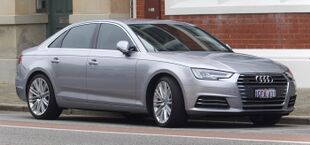 | |
| Overview | |
| Production | 2015–present[57] |
| Model years | 2016–present |
| Designer | Frank Rimili Rüdiger Müller (interior) Amar Vaya (facelift) |
| Body and chassis | |
| Body style | 4-door saloon/sedan, 5-door Avant (estate/wagon) |
| Platform | Volkswagen Group MLB Evo platform |
| Related | Audi A5 Audi Q7 |
| Powertrain | |
| Engine |
Inline-four diesel engine
V6 diesel engine
|
| Transmission | 6-speed manual 7-speed S-tronic 8-speed Tiptronic |
| Dimensions | |
| Wheelbase | 2,820 mm (111.0 in) |
| Length | 4,726–4,762 mm (186.1–187.5 in) |
| Width | 1,842–1,847 mm (72.5–72.7 in) |
| Height | 1,427 mm (56.2 in) |
The fifth-generation of the A4 was revealed in June 2015 when pre-production versions were released to the motoring press, with the official launch occurring at the Frankfurt Motor Show in September 2015.[58] This generation of the A4 is the fifth to carry the A4 badge and is commonly referred to as the B9, representing the ninth generation of the Audi 80/A4 series, which were originally (but no longer) based on the B platform. The B9 is slightly larger than the outgoing B8, but Audi claims the new A4 is around 120 kg (265 lb) lighter than its predecessor.
Available model grades are Premium, Premium Plus, Ultra Premium, Ultra Premium Plus and Prestige. Ultra models featured improved fuel efficiency and reduced emissions, and were only available in the FWD configuration. Every other model was available in either FWD or Quattro. The S Line and Black Optic packages were also made available. The S Line package uses skirts, bumpers, seats and wheels from the Audi S4, and adds an aluminum inlay to the interior consoles. The Black Optic package, or Black Edition, also uses the S4's body kit, but replaces the exterior's chrome trim with black counterparts.
A slight facelift was introduced in 2019, featuring new front and rear bumpers inspired by the Audi RS 4. Additionally, the Titanium model grade was introduced to replace the Ultra Premium and Ultra Premium Plus models.
Facelift (2020-present)
The facelift model, also known as the B9.5, was made available in 2020. It brought the A4's aesthetic in line with the S4, A6, A7 and A8. In addition to redesigned headlights and taillights, almost every body panel on the A4 was altered, with only the hood, trunk and roof remaining untouched. Notably, the character line that ran the length of the A4 was removed, with creases added to the front and rear fenders in its place. While the interior was largely untouched, the mechanical controls for the infotainment center were replaced with a touchscreen and larger display. Following the facelift, the A4 and S4 now share their body panels, with their grilles and badges being the only external distinctions between the models.
Post-facelift, the Titanium model was removed from production, leaving only the Premium, Premium Plus and Prestige model grades. Additionally, Post-facelift A4's are only available in the Quattro configuration. The Black Optic and S Line packages also return for select models. The Black Optic package can be equipped on any Premium Plus or Prestige Model, while the S Line model can be applied to any Premium Plus or Prestige Model with a 45 TFSI engine. The S Line package makes no changes to the exterior beyond its badging, as the A4 and S4 now share their body kits. It instead provides an aluminum inlay for the interior, improved seats, and stainless steel pedals.
In addition to the above packages, Audi also manufactures aftermarket accessories for the A4, including decals, spoilers, mirror caps and tail pipes.
-
Sedan / Saloon
-
Sedan / Saloon (facelift)
-
A4L
-
Avant
-
Avant (facelift)
-
Allroad quattro (front)
-
Allroad Quattro (rear)
-
Interior
-
Allroad quattro (facelift)
-
Allroad quattro (facelift)
Engines
Seven engines are available from launch, three petrol, and four diesel.[58] All are available in both the A4 Saloon and A4 Avant. The figures below are for the saloon only.
| Engine type | Max. power | Max. torque | 0–100 km/h (62 mph) | Top speed | CO2 emissions | Fuel consumption (combined) |
|---|---|---|---|---|---|---|
| Petrol engines | ||||||
| 1.4 TFSI / 2.0 TFSI (35 TFSI) | 150 PS (110 kW; 148 bhp) | 250 N⋅m (184 lb⋅ft) @ 1500-3500 rpm | 8.5 s | 210 km/h (130 mph) | 131 g/km | 5.5 L/100 km (51 mpg‑imp; 43 mpg‑US) |
| 2.0 TFSI ultra (40 TFSI / 40 TFSI quattro) | 190 PS (140 kW; 187 bhp) | 320 N⋅m (236 lb⋅ft) @ 1450-4200 rpm | 7.2 s | 240 km/h (149 mph) | 124 g/km | 5.5 L/100 km (51 mpg‑imp; 43 mpg‑US) |
| 2.0 TFSI (45 TFSI / 45 TFSI quattro) | 252 PS (185 kW; 249 bhp) | 370 N⋅m (273 lb⋅ft) @ 1600-4500 rpm | 5.8 s | 250 km/h (155 mph) | 137 g/km | 5.9 L/100 km (48 mpg‑imp; 40 mpg‑US) |
| 3.0 V6 TFSI (S4) | 354 PS (260 kW; 349 bhp) | 500 N⋅m (369 lb⋅ft) @ 1370-4500 rpm | 4.4 s | 250 km/h (155 mph) | 170 g/km | 7.5 L/100 km (38 mpg‑imp; 31 mpg‑US) |
| 2.9 V6 TFSI (RS4) | 450 PS (331 kW; 444 bhp) | 600 N⋅m (443 lb⋅ft) @ 1900-5000 rpm | 4.1 s | 250 km/h (155 mph) | 200 g/km | 8.8 L/100 km (32 mpg‑imp; 27 mpg‑US) |
| Diesel engines | ||||||
| 2.0 TDI (30 TDI) | 136 PS (100 kW; 134 bhp) | 320 N⋅m (236 lb⋅ft) @ 1500-3000 rpm | 9.2 s | 210 km/h (130 mph) | 111 g/km 98 g/km |
4.2 L/100 km (67 mpg‑imp; 56 mpg‑US) 3.8 L/100 km (74 mpg‑imp; 62 mpg‑US) |
| 2.0 TDI (35 TDI) | 150 PS (110 kW; 148 bhp) | 320 N⋅m (236 lb⋅ft) @ 1500-3250 rpm | 8.9 s | 221 km/h (137 mph) 210 km/h (130 mph) |
111 g/km 99 g/km |
4.2 L/100 km (67 mpg‑imp; 56 mpg‑US) 3.8 L/100 km (74 mpg‑imp; 62 mpg‑US) |
| 2.0 TDI ultra (40 TDI/ 40 TDI quattro) | 190 PS (140 kW; 187 bhp) | 400 N⋅m (295 lb⋅ft) @ 1750-3000 rpm | 7.7 s | 240 km/h (149 mph) 210 km/h (130 mph) |
118 g/km 102 g/km |
4.5 L/100 km (63 mpg‑imp; 52 mpg‑US) 3.9 L/100 km (72 mpg‑imp; 60 mpg‑US) |
| 3.0 TDI V6 (45 TDI) | 218 PS (160 kW; 215 bhp) | 500 N⋅m (369 lb⋅ft) @ 1250-3750 rpm | 6.6 s | 250 km/h (155 mph) | 117 g/km | 4.5 L/100 km (63 mpg‑imp; 52 mpg‑US) |
| 3.0 TDI V6 quattro (50 TDI) | 272 PS (200 kW; 268 bhp) | 600 N⋅m (443 lb⋅ft) @ 1500-3000 rpm | 5.3 s | 250 km/h (155 mph) | 137 g/km | 5.2 L/100 km (54 mpg‑imp; 45 mpg‑US) |
| 3.0 TDI V6 quattro (S4 TDI) | 347 PS (255 kW; 342 bhp) | 700 N⋅m (516 lb⋅ft) @ 1500-3000 rpm | 4.7 s | 250 km/h (155 mph) | 193 g/km | 7.4 L/100 km (38 mpg‑imp; 32 mpg‑US) |
Motorsport
A4 DTM

Audi Sport re-entered the Deutsche Tourenwagen Masters (DTM) series in 2004 (after having privateer teams run the Abt Sportsline Audi TT-R) with a V8 engined silhouette racing car resembling the A4 saloon, known as the Audi A4 DTM.[59][failed verification] A4 DTM cars are identified by Audi Sport "R"-prefix designations.[60]
Australian Super Touring Championship
Brad Jones won the Australian Super Touring Championship in both 1996 and 1998 driving an A4.
BTCC

The A4 was used in the 1996–1998 and 2011-2015 British Touring Car Championship seasons.

ETCC
The A4 was used in the 2000–2001 European Super Touring Championship season.
Italian touring cars
A4 drivers won the Italian Superturismo Championship in 1995 and 1996.
STCC
Drivers in an A4 won 2001, 2002, 2003, and the 2006 Swedish Touring Car Championship season.
STW
The A4 was entered into the 1995 Super Tourenwagen Cup season.
RTCC
The car was used in the 2006 Russian Touring Car Championship.
SCCA
The A4 was used in the SCCA World Challenge for several years.
Renaming
In March 2023, Audi CEO Markus Duesmann did confirm that the A4 would be renamed the A5, while the A6 would become the A7, with the future A4 and A6 to be sold as electric vehicles only.[61]
See also
- Volkswagen Group China
References
Notes
- ↑ Steinert, Christian (22 August 2006). "Audi: New sales division in China". The German Car Blog. http://www.germancarblog.com/2006/08/audi-new-sales-division-in-china.html.
- ↑ "A history of Audi – The 1990s". Audi UK. https://www.audi.co.uk/content/dam/audi/production/RestOfSite/FleetSales/03_2010/PDF/History/AudiHistory_90s_161009.pdf.
- ↑ "Design skecht front quarter view" (JPG). http://farm6.staticflickr.com/5453/8956302074_d77142cf68_o.jpg.
- ↑ Buckley, Martin (2002). "The 1990s: New Models, New Markets, New Directions". BMW Cars. Motorbooks. p. 158. ISBN 978-0-7603-0921-6.
- ↑ "Audi A4". http://www.autogush.com/6671-audi-a4.html#.Ucx_o_nVCK9.
- ↑ Neil, Dan (7 January 1996). "BEHIND THE WHEEL/Audi A4 Quattro;Athletic Overachiever at a Garage-Sale Price". The New York Times. https://www.nytimes.com/1996/01/07/automobiles/behind-the-wheel-audi-a4-quattro-athletic-overachiever-at-a-garage-sale-price.html.
- ↑ "Picture" (JPG). https://www.audiworld.com/news/99/sketches/sketch7.jpg.
- ↑ "Design sketch of exterior" (JPG). https://www.audiworld.com/news/99/sketches/sketch5.jpg.
- ↑ "Design sketch of dashboard" (JPG). https://www.audiworld.com/news/99/sketches/sketch13.jpg.
- ↑ "Design sketch of door panel" (JPG). https://www.audiworld.com/news/99/sketches/sketch14.jpg.
- ↑ Fujita, Mai (1998). "Industrial Policies and Trade Liberalization: The Automotive Industry in Thailand and Malaysia". in Omura, Keiji. The Deepening Economic Interdependence in the APEC Region. Singapore: APEC Study Center, Institute of Developing Economies. p. 152. http://202.244.105.129/English/Publish/Download/Apec/pdf/1997_06.pdf.[yes|permanent dead link|dead link}}]
- ↑ Audi Sport FAQ, retrieved 2012-04-01
- ↑ "Audi specs, dimensions, fuel consumption". https://www.ultimatespecs.com/car-specs/Audi.
- ↑ "Audi A4". EuroNCAP.com. http://www.euroncap.com/tests/audi_a4_1997/14.aspx.
- ↑ Audi.com Audi Q7 hybrid – making a clean start [failed verification]
- ↑ Audi.com Audi Q7 hybrid concept – 15 years of pioneering work [failed verification]
- ↑ "Production of the New Audi A4 Cabriolet". 26 March 2002. https://www.audiworld.com/articles/production-of-the-new-audi-a4-cabriolet/.
- ↑ "Audi Gearbox Problems". http://www.audi-gearbox-problems.co.uk.
- ↑ "CVT reality check". http://www.audi-forums.com/b6-forum/47603-cvt-reality-check.html.
- ↑ "Audi A4 specification". 2011. http://www.boldride.com/ride/2000/audi-a4#gallery/4.
- ↑ "Audi A4". EuroNCAP.com. http://www.euroncap.com/tests/audi_a4_2001/88.aspx.
- ↑ "IIHS-HLDI: Audi A4". Iihs.org. 24 October 2007. http://www.iihs.org/ratings/rating.aspx?id=163.
- ↑ The competitor: BMW E93 Convertible
- ↑ "Letztes Audi A4-Cabriolet läuft heute vom Band" (in de). Nord-West-Media TV. Nord-West-Media TV & Nachrichten GmbH. 2009-02-20. http://www.nord-west-media.de/index.php?id=3198.
- ↑ "Car unserviceabilities frequency sequence". Archived from the original on 18 December 2008. https://web.archive.org/web/20081218221850/http://www.tuulilasi.fi/valokeila/?subarea=uutiset&article=149985&page=2.
- ↑ Kirk, Julian (4 November 2008). "Seat Exeo (2009) CAR review". Car Magazine. http://www.carmagazine.co.uk/Drives/Search-Results/First-drives/SEAT-Exeo-first-drive/.
- ↑ 27.0 27.1 "Audi A4". Insurance Institute for Highway Safety, Highway Loss Data Institute. http://www.iihs.org/ratings/ratingsbyseries.aspx?id=558.
- ↑ IIHS.org TOP SAFETY PICK past winners
- ↑ "Audi starts production of new Audi A4 in India". https://www.automobilesreview.com/auto-news/audi-starts-production-audi-a4-india/5106/.
- ↑ "portfolio — julian höenig". http://www.julianhoenig.com/art/about_files/portfolio.pdf.
- ↑ "Audi A4: the design". carbodydesign.com. http://www.carbodydesign.com/archive/2007/11/07-audi-a4-design/.
- ↑ Monticello, Mike (October 2008), "2009 Audi A4 3.2 Quattro", Road & Track 60 (2): 104
- ↑ Audi A5 – Self Study Programme. Audi AG. January 2007. p. 30. http://training.avme.net/admin/Upload/SSP/4801_392%20Audi%20A5%20generell.pdf. Retrieved 5 January 2015.
- ↑ Rutherford, Mike (6 November 2007). "Audi A4 replacement: Hot and cool". iol.co.za. http://www.iol.co.za/motoring/latest-launches/audi-a4-replacement-hot-and-cool-1.852835.
- ↑ Ulrich, Lawrence (27 December 2009). "A Holiday From Wishful Thinking". The New York Times. https://www.nytimes.com/2009/12/27/automobiles/27ulrich-best.html?pagewanted=2&_r=1&sq=Ford%20Taurus%20disappointing&st=cse&scp=1.
- ↑ Ulrich, Lawrence (8 February 2009). "A Class Act Matures in Size and Price". The New York Times. https://www.nytimes.com/2009/02/08/automobiles/autoreviews/08audi-a4.html?_r=1&pagewanted=2.
- ↑ "2009 Audi A4 Review, Prices, Photos". New Car Test Drive. http://www.newcartestdrive.com/review-intro.cfm?Vehicle=2009_Audi_A4&ReviewID=4525.
- ↑ "MY10 changes for Australian Audi range". Ozaudi.com. http://www.ozaudi.com/forums/showthread.php/19978-MY10-changes-for-Australian-Audi-range.
- ↑ "The Audi A4 allroad quattro: A Vehicle that knows no Boundaries". www.audi.com. Audi AG. 15 February 2009. http://www.audi.com/com/brand/en/company/news/models_and_services.detail.2009~02~the_audi_a4_allroad.html.
- ↑ Paukert, Chris (3 April 2009). "Geneva 2009: New Audi A4 Allroad debuts, reportedly may come to U.S. after all". Autoblog.com. http://www.autoblog.com/2009/03/04/geneva-2009-new-audi-a4-allroad-debuts-reportedly-may-come-to/.
- ↑ Tan, Paul (2008-11-17). "New extended Audi A4L for the China market". PaulTan.org. https://paultan.org/2008/11/17/new-extended-audi-a4l-for-the-china-market/.
- ↑ Filipponio, Frank (17 November 2008). "Audi intros long-wheelbase A4L for China". Autoblog.com. http://www.autoblog.com/2008/11/17/audi-intros-long-wheelbase-a4-for-china/.
- ↑ Audi.co.uk The new Audi A4, A4 allroad and S4 range, Pricing and Specification Guide, Valid from April 2009, Edition 6.1. 04/09
- ↑ Audi South Africa A4 specifications
- ↑ Audi Australia The Audi A4
- ↑ Audi New Zealand MY09 A4 Specification and Option Sheet
- ↑ Lavrinc, Damon (22 April 2009). "Audi dropping 3.2-liter V6 from 2010 A3, A4 and TT". Autoblog.com. http://www.autoblog.com/2009/04/22/audi-dropping-3-2-liter-v6-from-2010-a3-a4-and-tt/.
- ↑ "Audi A4 2.0 TDIe". https://www.autocar.co.uk/car-review/audi/a4/first-drives/audi-a4-20-tdie.
- ↑ AutoBlog.com Audi A4 and A5 get S-Tronic gearbox abroad, U.S. still waiting
- ↑ "Audi CVT Suit Settlement Given Green Light". The National Trial Lawyers. http://www.thenationaltriallawyers.org/2013/10/audi-cvt-suit-settlement-given-green-light/.
- ↑ "2009 Audi A4 3.2 quattro sedan Review". Automoblog.net. http://www.automoblog.net/2009/03/26/2009-audi-a4-review/.
- ↑ "Audi A4". EuroNCAP.com. http://www.EuroNCAP.com/tests/Audi_A4_2008/320.aspx.
- ↑ "Audi A4". euroncap.com. http://www.euroncap.com/results/audi/a4/2009/350.aspx.
- ↑ "2012 Audi A4 4 DR FWD". safercar.gov. http://www.safercar.gov/Vehicle+Shoppers/5-Star+Safety+Ratings/2011-Newer+Vehicles/Vehicle-Detail?vehicleId=6350.
- ↑ "AutomobileMag.com". AutomobileMag.com. http://www.automobilemag.com/auto_shows/2008_paris/0810_audi_a4_tdi_concept_e/index.html.
- ↑ AutoBlogGreen.com Audi unveils A4 TDI concept e
- ↑ "High tech all the way – the new Audi A4 and A4 Avant". Audi AG. 4 September 2015. https://www.audi-mediacenter.com/en/4328.
- ↑ 58.0 58.1 "2015 Audi A4 - latest pictures and details - Autocar". http://www.autocar.co.uk/car-news/new-cars/2015-audi-a4-revealed.
- ↑ Audi.co.uk The Audi A4 DTM
- ↑ "Three Generations of Audi A4 DTM Cars". Audiworld.com. 27 March 2006. http://www.audiworld.com/news/06/032706/content.shtml.
- ↑ "Audi Boss Confirms A4 Will Be Renamed A5 While The A6 Will Become The A7". March 17, 2023. https://www.motor1.com/news/657772/audi-a4-renamed-a5-confirmed/.
Bibliography
- Kohoutek, Peter, ed (2008) (in de). Der neue Audi A4: Entwicklung und Technik. ATZ/MTZ-Typenbuch series. Wiesbaden, Germany: Vieweg. ISBN 9783834803993.
External links
 |






